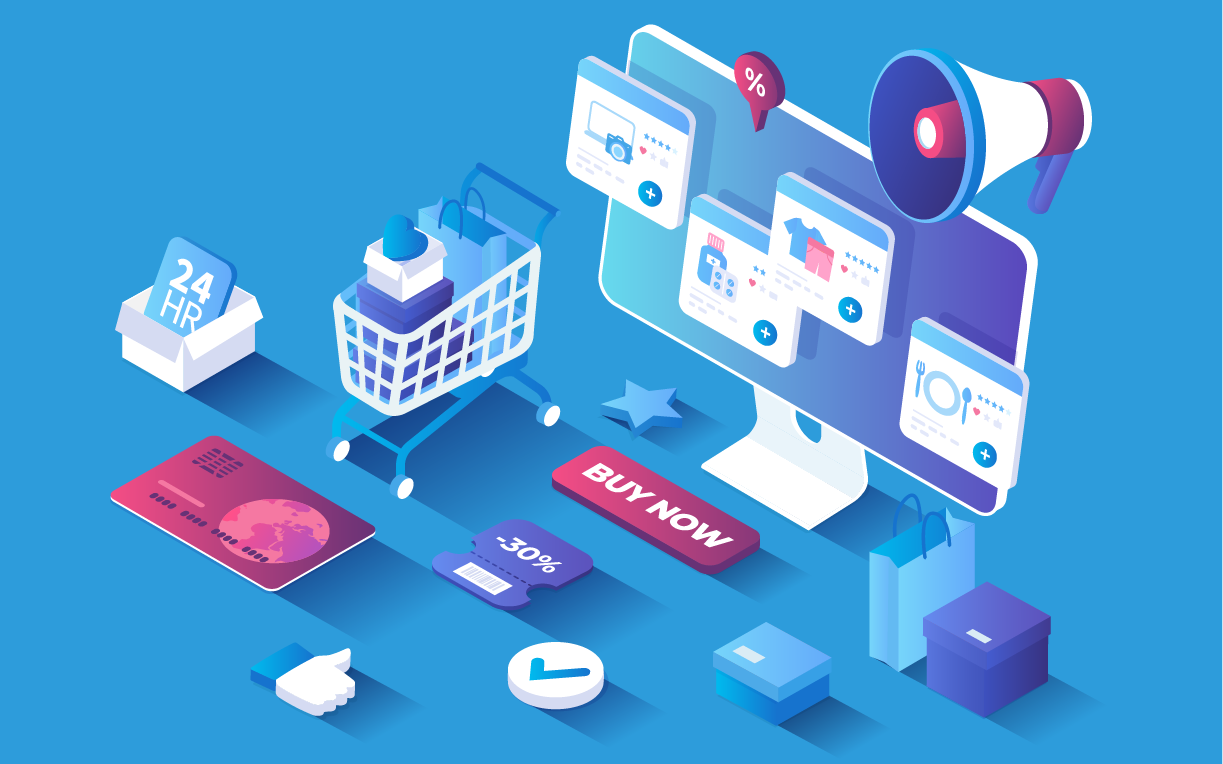By Almira Abad on Apr 21, 2023 4:00:00 PM
In today’s digital age, social media has become an integral part of our daily lives. It has also become a vital tool for businesses to reach and engage with their target audience. E-commerce brands, in particular, have embraced social media as a means to drive sales and build brand awareness. However, while Facebook has been the go-to platform for many e-commerce brands, it’s not the only platform available. In this article, we’ll explore alternative platforms such as Instagram, TikTok, and Pinterest and how they can be used effectively for e-commerce advertising.

Instagram: Instagram has become one of the most popular social media platforms in recent years, with over 1 billion monthly active users. As a visual-based platform, it’s the perfect platform for e-commerce brands to showcase their products and connect with their audience. Instagram also has a range of advertising options, such as photo ads, video ads, carousel ads, and stories ads. E-commerce brands can leverage these options to showcase their products, highlight promotions, and drive sales. Instagram’s shopping feature also allows e-commerce brands to tag their products in posts and stories, making it easy for users to shop directly from the platform.
Why use Instagram for e-commerce advertising?
- Visual Content: Instagram is a visual-based platform, making it an ideal platform for e-commerce advertising. E-commerce brands can showcase their products through high-quality images, videos, and stories, providing consumers with a more immersive and engaging shopping experience.
- Large Audience: With over one billion active monthly users, Instagram offers a vast audience for e-commerce brands to target. The platform also offers advanced targeting options, allowing businesses to reach their ideal audience based on demographics, interests, and behaviors.
- Advertising Options: Instagram offers a range of advertising options, such as photo ads, video ads, carousel ads, and stories ads. These options allow e-commerce brands to showcase their products, highlight promotions, and drive sales.
- Shopping Feature: Instagram’s shopping feature allows e-commerce brands to tag their products in posts and stories, making it easy for users to shop directly from the platform. This feature has simplified the shopping experience for users, making it more likely for them to make a purchase.
TikTok: TikTok is a relatively new social media platform that has taken the world by storm. It has over 1 billion monthly active users, with the majority of its users being between the ages of 16-24. TikTok’s algorithm allows content to go viral quickly, making it an ideal platform for e-commerce brands to reach a broader audience. TikTok also offers a range of advertising options, such as in-feed video ads, brand takeovers, and hashtag challenges. E-commerce brands can use these options to showcase their products and create engaging content that resonates with their target audience.
Why use TikTok for e-commerce advertising?
- Younger Audience: TikTok has a younger audience compared to other social media platforms, with a significant number of users between 18-24 years old. This age group is an essential demographic for e-commerce brands, making TikTok an ideal platform for reaching them.
- Viral Potential: TikTok’s algorithm favors content that is engaging and has the potential to go viral. E-commerce brands can create compelling and entertaining content that has the potential to reach a large audience, resulting in increased brand awareness and sales.
- Advertising Options: TikTok offers various advertising options, including in-feed video ads, brand takeover ads, and hashtag challenges. These options allow e-commerce brands to showcase their products, promote special offers, and engage with their target audience.
- Creative Freedom: TikTok offers e-commerce brands creative freedom to showcase their products in unique and engaging ways. Brands can create short-form videos that showcase their products in action, tell a story, or entertain their audience.
Pinterest: Pinterest is a visual-based platform that allows users to discover and save ideas and inspiration for various projects and interests. It has over 450 million monthly active users, with the majority of its users being women. Pinterest is an excellent platform for e-commerce brands that cater to women, such as fashion, beauty, and home decor. E-commerce brands can create visually appealing pins that showcase their products and link them to their website. Pinterest also offers advertising options such as promoted pins, which appear at the top of search results and category feeds.
Why use Pinterest for e-commerce advertising?
- High Intent Audience: Pinterest users are actively searching for inspiration and ideas, making them a high-intent audience. This means that users on Pinterest are more likely to engage with content that aligns with their interests, including products they are interested in purchasing.
- Visual Discovery: Pinterest is a visual platform, making it an ideal platform for showcasing products. E-commerce brands can use high-quality visuals to showcase their products, making them more appealing to users.
- Long-Term Exposure: Unlike other social media platforms, content on Pinterest has a longer lifespan. Pins can continue to gain engagement and impressions over time, resulting in increased brand awareness and sales.
- Targeted Advertising: Pinterest offers a range of advertising options, including Promoted Pins, Promoted Videos, and Promoted Carousels. These options allow e-commerce brands to target their audience based on demographics, interests, and behaviors, resulting in more effective and efficient advertising.

Snapchat: Snapchat is a popular social media platform among younger audiences, with over 280 million monthly active users. Snapchat’s unique feature is its ephemeral content, which disappears after 24 hours. E-commerce brands can use Snapchat to create behind-the-scenes content, showcase limited edition products, and highlight promotions. Snapchat also offers advertising options such as snap ads, which are full-screen video ads that appear in between user stories.
Why use Snapchat for e-commerce advertising?
- Younger Audience: Snapchat’s audience is predominantly young, with over 75% of its users under the age of 34. This makes Snapchat an excellent platform for e-commerce brands targeting a younger demographic.
- High Engagement: Snapchat users are highly engaged, with over 60% of its daily active users creating and sharing content on the platform. This means that e-commerce brands can create engaging content that resonates with their target audience, leading to increased brand awareness and sales.
- Creative Ad Formats: Snapchat offers a range of ad formats, including Snap Ads, Sponsored Lenses, and Sponsored Filters. These ad formats allow e-commerce brands to showcase their products in unique and creative ways, making them more appealing to Snapchat users.
- In-App Shopping: Snapchat has recently introduced in-app shopping features, allowing e-commerce brands to sell products directly to their Snapchat audience. This can lead to increased sales and revenue for e-commerce brands.
LinkedIn: While LinkedIn may not be the first platform that comes to mind when it comes to e-commerce advertising, it’s an excellent platform for B2B e-commerce brands. LinkedIn has over 700 million monthly active users, with a majority of its users being professionals. E-commerce brands can use LinkedIn to showcase their products to other businesses, such as office supplies, software, and equipment. LinkedIn also offers advertising options such as sponsored content, which appears in users’ feeds, and sponsored InMail, which allows e-commerce brands to send targeted messages to their audience.
Why use LinkedIn for e-commerce advertising?
- Professional Audience: LinkedIn’s audience is made up of professionals, making it a great platform for e-commerce brands targeting a professional demographic. This audience is interested in staying up-to-date on industry news, trends, and best practices, making them more likely to engage with relevant e-commerce content.
- High Purchasing Power: LinkedIn users have a high purchasing power, making them more likely to make purchases from e-commerce brands. This means that e-commerce brands can reach a highly qualified audience that has the potential to generate significant revenue.
- Multiple Ad Formats: LinkedIn offers a range of ad formats, including Sponsored Content, Sponsored InMail, and Display Ads. This allows e-commerce brands to create targeted and engaging ads that resonate with their target audience.
- Targeted Advertising: LinkedIn allows e-commerce brands to target their audience based on job title, company size, industry, location, and more. This means that e-commerce brands can reach the right audience with the right message.
In conclusion, while Facebook may be the most popular platform for e-commerce advertising, there are other platforms that e-commerce brands can leverage to reach and engage with their target audience. Instagram, TikTok, Pinterest, Snapchat, and LinkedIn are all excellent platforms that offer unique advertising options that can help e-commerce brands drive sales and build brand awareness.




comments